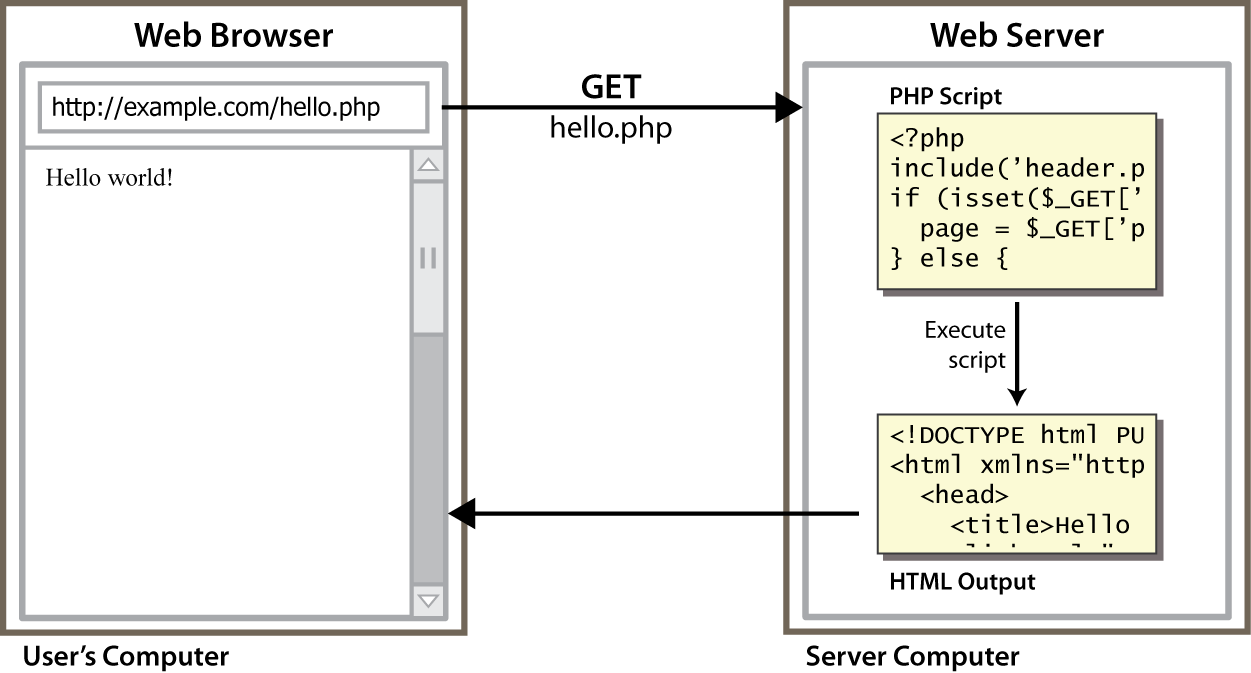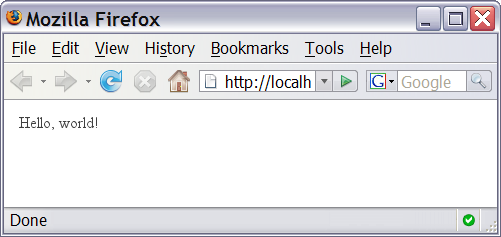Web Programming Step by Step, 2nd Edition
Lecture 6: Intro to PHP
Reading: 5.1 - 5.2
Except where otherwise noted, the contents of this document are Copyright 2012 Marty Stepp, Jessica Miller, and Victoria Kirst. All rights reserved. Any redistribution, reproduction, transmission, or storage of part or all of the contents in any form is prohibited without the author's expressed written permission.
5.1: Server-Side Basics
- 5.1: Server-Side Basics
- 5.2: PHP Basic Syntax
- 5.3: Embedded PHP
- 5.4: Advanced PHP Syntax
URLs and web servers
http://server/path/file
- usually when you type a URL in your browser:
- your computer looks up the server's IP address using DNS
- your browser connects to that IP address and requests the given file
- the web server software (e.g. Apache) grabs that file from the server's local file system, and sends back its contents to you
- some URLs actually specify programs that the web server should run, and then send their output back to you as the result:
https://webster.cs.washington.edu/cse190m/quote.php
- the above URL tells the server
webster.cs.washington.eduto run the programquote2.phpand send back its output
- the above URL tells the server
Server-Side web programming




- server-side pages are programs written using one of many web programming languages/frameworks
- the web server contains software that allows it to run those programs and send back their output
- each language/framework has its pros and cons
- we use PHP for server-side programming in this textbook
What is PHP?

- PHP stands for "PHP Hypertext Preprocessor"
- a server-side scripting language
- used to make web pages dynamic:
- provide different content depending on context
- interface with other services: database, e-mail, etc
- authenticate users
- process form information
- PHP code can be embedded in XHTML code
Lifecycle of a PHP web request

- browser requests a
.htmlfile (static content): server just sends that file - browser requests a
.phpfile (dynamic content): server reads it, runs any script code inside it, then sends result across the network- script produces output that becomes the response sent back
Why PHP?
There are many other options for server-side languages: Ruby on Rails, JSP, ASP.NET, etc. Why choose PHP?
- free and open source: anyone can run a PHP-enabled server free of charge
- compatible: supported by most popular web servers
- simple: lots of built-in functionality; familiar syntax
- available: installed on UW's servers (Dante, Webster) and most commercial web hosts
- well-documented: type
php.net/functionNamein browser Address bar to get docs for any function
Hello, World!
The following contents could go into a file hello.php:
<?php print "Hello, world!"; ?>
Hello, world!
- a block or file of PHP code begins with
<?phpand ends with?> - PHP statements, function declarations, etc. appear between these endpoints
Viewing PHP output


- you can't view your
.phppage on your local hard drive; you'll either see nothing or see the PHP source code - if you upload the file to a PHP-enabled web server, requesting the
.phpfile will run the program and send you back its output
5.2: PHP Basic Syntax
- 5.1: Server-Side Basics
- 5.2: PHP Basic Syntax
- 5.3: Embedded PHP
- 5.4: Advanced PHP Syntax
Console output: print
print "text";
print "Hello, World!\n"; print "Escape \"chars\" are the SAME as in Java!\n"; print "You can have line breaks in a string."; print 'A string can use "single-quotes". It\'s cool!';
Hello, World!
Escape "chars" are the SAME as in Java!
You can have
line breaks in a string.
A string can use "single-quotes". It's cool!
- some PHP programmers use the equivalent
echoinstead ofprint
Arithmetic operators
-
+ - * / %
. ++ --
= += -= *= /= %= .=
- many operators auto-convert types:
5 + "7"is12
Variables
$name = expression;
$user_name = "PinkHeartLuvr78"; $age = 16; $drinking_age = $age + 5; $this_class_rocks = TRUE;
- names are case sensitive; separate multiple words with _
- names always begin with
$, on both declaration and usage - implicitly declared by assignment (type is not written; a "loosely typed" language)
Types
Comments
# single-line comment // single-line comment /* multi-line comment */
- like Java, but
#is also allowed- a lot of PHP code uses
#comments instead of// - we recommend
#and will use it in our examples
- a lot of PHP code uses
for loop
for (initialization; condition; update) {
statements;
}
for ($i = 0; $i < 10; $i++) {
print "$i squared is " . $i * $i . ".\n";
}
if/else statement
if (condition) {
statements;
} elseif (condition) {
statements;
} else {
statements;
}
- NOTE: although
elseifkeyword is much more common,else ifis also supported

